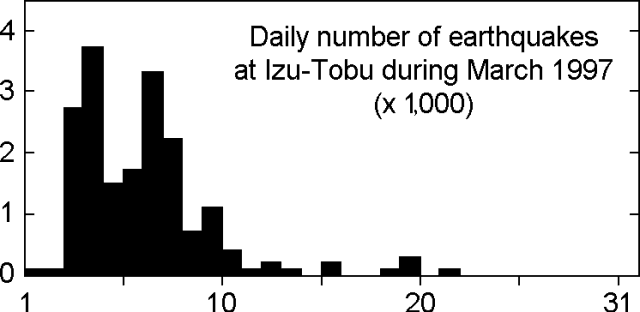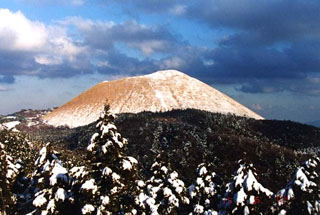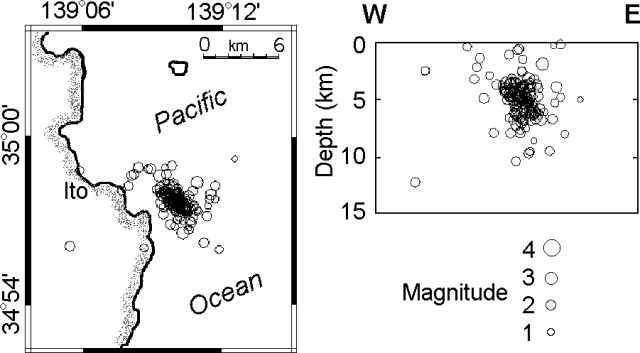Report on Izu-Tobu (Japan) — February 1997
Bulletin of the Global Volcanism Network, vol. 22, no. 2 (February 1997)
Managing Editor: Richard Wunderman.
Izu-Tobu (Japan) A large earthquake swarm starts on 3 March
Please cite this report as:
Global Volcanism Program, 1997. Report on Izu-Tobu (Japan) (Wunderman, R., ed.). Bulletin of the Global Volcanism Network, 22:2. Smithsonian Institution. https://doi.org/10.5479/si.GVP.BGVN199702-283010
Izu-Tobu
Japan
34.9°N, 139.098°E; summit elev. 1406 m
All times are local (unless otherwise noted)
About a month prior to a large seismic swarm, seismicity increased around the coastline N of Ito City; on 8 February JMA's Kamata seismic station recorded 20 events, the largest of which was M 3.5. The earthquake total for February was 59.
The large earthquake swarm started on 3 March adjacent to Ito City, a coastal town along the E side of the Izu Peninsula's neck. A migrating swarm had occurred in the same general region during 1995 (BGVN 20:09). The earthquake swarm that began on 3 March occurred in an EW-trending zone, 0-5 km offshore at depths of 2-10 km (figure 17). Small low-frequency earthquakes were reported during 4-6 March but none afterwards. Although the frequency of earthquakes declined after the morning of 5 March, they increased again in the afternoon of 6 March, creating a second seismic peak (figure 18).
 |
Figure 18. Daily number of earthquakes recorded at Kamata seismic station (1-31 March 1997). Courtesy of JMA. |
Aircraft surveys of the epicentral area were made on 7 and 9 March by the Hydrographic Department of the Maritime Safety Agency. The sea surface was not stained or discolored.
Seismic activity declined after 9 March, and ended on 12 March. The total number of earthquakes recorded at the Kamata Station (10 km SW of the first swarm) was 9,080, including 441 felt events. During March four earthquakes had M >5.0; the strongest one, M 5.7, occurred on 4 March.
GPS data gathered by the Geographical Survey Institute in the E part of the peninsula showed a continuous steady swelling of the region around the main earthquake swarm during 3-8 March. The rate of ground deformation (determined with GPS, tiltmeter, and volumetric strain meter) slowed down after 9 March. The ~12-km-long line between Hatsushima and Komuroyama, crossing above the swarm location, extended by a total of 13 cm. The accumulated strain at the Higashi-Izu JMA Station (~20 km SSW of the swarm) was ~6 x 107.
Geological Summary. The Izu-Tobu volcano group (Higashi-Izu volcano group) is scattered over a broad, plateau-like area of more than 400 km2 on the E side of the Izu Peninsula. Construction of several stratovolcanoes continued throughout much of the Pleistocene and overlapped with growth of smaller monogenetic volcanoes beginning about 300,000 years ago. About 70 subaerial monogenetic volcanoes formed during the last 140,000 years, and chemically similar submarine cones are located offshore. These volcanoes are located on a basement of late-Tertiary volcanic rocks and related sediments and on the flanks of three Quaternary stratovolcanoes: Amagi, Tenshi, and Usami. Some eruptive vents are controlled by fissure systems trending NW-SE or NE-SW. Thirteen eruptive episodes have been documented during the past 32,000 years. Kawagodaira maar produced pyroclastic flows during the largest Holocene eruption about 3,000 years ago. The latest eruption occurred in 1989, when a small submarine crater was formed NE of Ito City.
Information Contacts: Volcanological Division, Japan Meteorological Agency (JMA), 1-3-4 Ote-machi, Chiyoda-ku, Tokyo 100, Japan; Masato Koyama, Shizuoka University, Institute of Geosciences, Ohya 836, Shizuoka-shi 422, Japan (URL: http://www.ipcs.shizuoka.ac.jp/~edmkoya/Izu/HIMVFe.html); Setsuya Nakada, Volcano Research Institute (VRI), University of Tokyo,Yayoi 1-1-1, Bunkyo-ku, Tokyo 113 Japan (URL: http://hakone.eri.u- tokyo.ac.jp/vrc/erup/izutobu.html).


